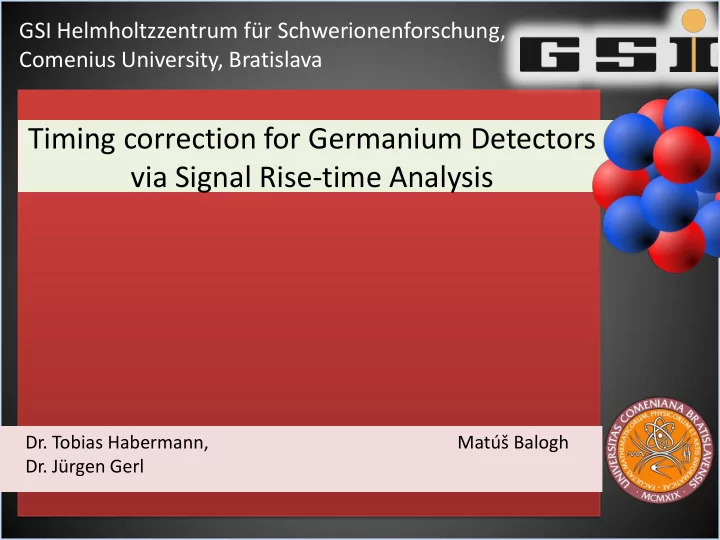

GSI Helmholtzzentrum für Schwerionenforschung, Comenius University, Bratislava Timing correction for Germanium Detectors via Signal Rise-time Analysis Fakulta Dr. Tobias Habermann, Matúš Balogh Dr. Jürgen Gerl
Timing correction for Germanium Detectors via Signal Rise-time Analysis Motivation • Technique to improve time resolution by using pulse rise time • Precise timing information can be used to suppress background radiation 104 Sn experiment courtesy of Giulia Guastalla g.guastalla@gsi.de 2
Timing correction for Germanium Detectors via Signal Rise-time Analysis Experimental setup Coincidence measurement using • Ortec GEM 28185-P HPGe • LaBr fast scintillator Radioactive sources • 60 Co • 22 Na FADC with 10 ns sampling resolution TDC with 90 ps resolution 3
Timing correction for Germanium Detectors via Signal Rise-time Analysis Data acquisition Preprocessing by TTree::MakeClass ROOT Go4 Go4 ROOT MBS new file Unpacker Sorting file Analysis 4
Timing correction for Germanium Detectors via Signal Rise-time Analysis Preprocessing • Subtracting baseline, normalizing and aligning pulses • Pulses only from photopeak events 5
Timing correction for Germanium Detectors via Signal Rise-time Analysis Preprocessing Rise time analysis – need to get rise times • not possible to obtain full rise time -> using partial rise times ( T x ) instead 𝑈 90 6
Timing correction for Germanium Detectors via Signal Rise-time Analysis Preprocessing Calculating time walk – difference between timing signal from LaBr and HPGe 𝐺𝑋𝐼𝑁 = 13,8 𝑜𝑡 𝐺𝑣𝑚𝑚 𝑥𝑗𝑒𝑢ℎ 𝑝𝑔 167 𝑜𝑡
Timing correction for Germanium Detectors via Signal Rise-time Analysis Analysis Confirmation of linear dependence between T walk and the rise times 𝑈 50 𝑤𝑡 𝑈 𝑥𝑏𝑚𝑙 𝑈 30 𝑤𝑡 𝑈 𝑥𝑏𝑚𝑙
Timing correction for Germanium Detectors via Signal Rise-time Analysis Analysis Dependence between 𝑈 𝑥𝑏𝑚𝑙 and rise time ( 𝑈 𝑦 ) was fitted by ROOT::TLinearFitter • In case of fitting 𝑈 𝑥𝑏𝑚𝑙 with single rise time: 𝑈 𝑥𝑏𝑚𝑙 = 𝛽𝑈 𝑦 + 𝛾 In case of fitting 𝑈 𝑥𝑏𝑚𝑙 with all rise times: • 𝑈 𝑥𝑏𝑚𝑙 = 𝛾 + 𝛽 𝑗 𝑈 𝑗 𝑗=20,30,…90 Subsequentaly data set was shifted according to the one of the equation • In case of single rise time fit: ′ 𝑈 𝑥𝑏𝑚𝑙 = 𝑈 𝑥𝑏𝑚𝑙 − 𝛽𝑈 𝑦 + 𝛾 • In case of all rise time fit: ′ 𝑈 𝑥𝑏𝑚𝑙 = 𝑈 𝑥𝑏𝑚𝑙 − 𝛾 + 𝛽 𝑗 𝑈 𝑗 𝑗=20,30,…90
Timing correction for Germanium Detectors via Signal Rise-time Analysis Analysis Single dependence Gated 𝑈 𝑥𝑏𝑚𝑙 𝑤𝑡 𝑈 50 dependence fitted using at least 70% of remaining data: • 𝐺𝑋𝐼𝑁 = 12,6𝑜𝑡 ( 13,8𝑜𝑡 ) 𝐺𝑣𝑚𝑚 𝑥𝑗𝑒𝑢ℎ 𝑝𝑔 138 𝑜𝑡 ( 167𝑜𝑡 ) • Original spectrum New spectrum
Timing correction for Germanium Detectors via Signal Rise-time Analysis Analysis Multi dependence Gated 𝑈 𝑥𝑏𝑚𝑙 𝑤𝑡 𝑏𝑚𝑚 𝑈 𝑦 fitted using at least 70% of remaining data: • 𝐺𝑋𝐼𝑁 = 14,2𝑜𝑡 ( 13,8𝑜𝑡 ) 𝐺𝑣𝑚𝑚 𝑥𝑗𝑒𝑢ℎ 𝑝𝑔 158 𝑜𝑡 ( 167𝑜𝑡 ) • Original spectrum New spectrum
Timing correction for Germanium Detectors via Signal Rise-time Analysis Outline • Continue to explore possibilities of the Signal Rise time Analysis • Application of Pulse Shape Analysis for further improvements in time resolution
GSI Helmholtzzentrum für Schwerionenforschung Comenius University, Bratislava Thank you for attention Matúš Balogh
Questions?
Recommend
More recommend